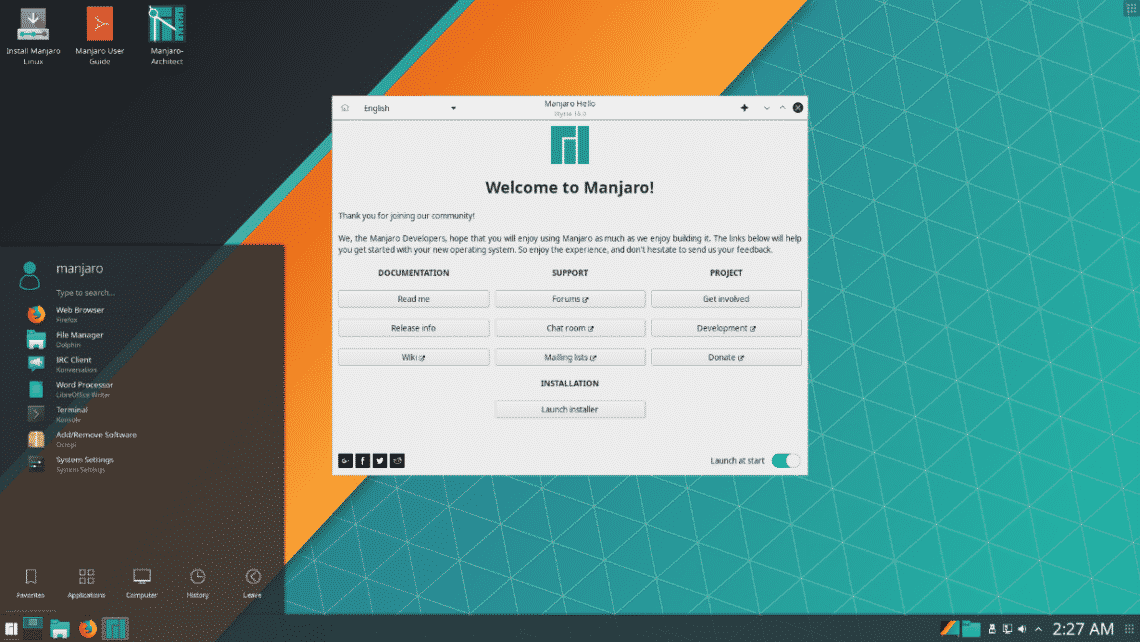Linux: History and Evolution
As a parent open-source software, Linux was released way back in 1991 with its UNIX-like operating systems that were based on the Linux Kernel. For operating systems on servers, mainframe computers, and supercomputers, Linux’s working environment proved a turning point in providing ease, security, and a reliable platform to code on. Some of the most popular distributions of Linux include Ubuntu, Mint, Arch Linux, Debian, and Fedora.
Manjaro Linux Vs. Ubuntu: Which one to pick?
When comparing the two Linux distributions, it is important to carefully weigh the pros and cons of each one of them. If you are a beginner with no experience with Linux at all, Ubuntu is a good first choice. On the other hand, Manjaro, which is relatively new, doesn’t have a community as large as Ubuntu’s, but it surely has a promising future in terms of its working platform, immediate releases, and software packages. Let us see a detailed breakdown of the two distros below.
1. SPECIFICATIONS
| SPECS | UBUNTU | MANJARO |
|---|---|---|
| Based On | Debian Stable | Arch Linux |
| Linux Kernel | 5.13 | 5.0 |
| Desktop Environment – Default | GNOME | KDE, XFCE, GNOME |
| Init System | Systemd | Systemd |
| Last Updated On | 23-04-2020 | 04-01-2022 |
| Supported Architectures | Amd64, i386 | X86-64 |
| Package Manager | dpkg | pacman |
| Release Schedule | 5 Year /6-month releases | Rolling Release |
| Version | Ubuntu 20.04 | Manjaro 21.2.1 |
2. PROS
Ubuntu

Ubuntu has been around for more than a decade now. Despite being ranked sixth among all the Linux distributions, Ubuntu has still been the most popular. It has a huge support community, including Ubuntu Wiki, Ask Ubuntu and Ubuntu Forums for both beginners and experts. Its simple interface, smooth installation process, less hassle for downloads, and configuration make it easier to be used by everyday people.
Ubuntu also has a fixed long-term release schedule of two years that includes default apps such as music, videos, and office applications. The best part of working on Ubuntu is its flexibility of working platforms. For instance, you don’t necessarily have to work on your laptop – Ubuntu can easily be accessed on any touchscreen device or tablet!
Besides that, Ubuntu is counted as the most stable distribution. Its customizable Gnome interface, Unified-searching options, and support for Non-Roman script have made the operating system a flexible option for both first-timers and new programmers.
Manjaro

Just within 8 years of its official release, Manjaro has achieved third place in the rankings of the best Linux distributions. It is among the few distros that are not built around Ubuntu but instead on Arch Linux. Manjaro allows users safe access to the Arch User Repository that contains Arch Linux packages and downloads. Since Manjaro doesn’t offer Personal Package Archive (PPA) downloads, its team maintains a large software repository that is updated every week.
While Arch is a great distribution platform to work on, installation and setups can sometimes be extremely challenging for beginners. This is where Manjaro comes in handy. It has removed this hassle. Its support for the Arch Linux distro and added benefits of being much more user-friendly than Arch itself make it a top choice for users.
Other than that, Manjaro also offers support for multiple kernels other than Linux and options to easily install and switch among them. The best part about Manjaro includes smooth installation, automatic updates for the latest kernels and packages, and improved stability. When compared to Ubuntu, Manjaro is a rolling-release distro where once you install the system, there is no need for a re-installation as long as you are regularly updating it!
Despite being new, Manjaro has managed to provide users and beginners with an easy and friendly interface, attractive desktop colors, a number of distribution-specific tools, and drivers to get started. It uses low system memory and automatically notifies of package updates.
3. CONS
Ubuntu
Ubuntu is a little old school as compared to Manjaro. Despite being out there for years, it still utilizes the default GNOME desktop environment, which requires high-end graphics and hardware to run smoothly. It is highly unsuitable for low-end systems, whereas each new version takes up to two years to release. Also, for every software download, you need PPA’s, which is another headache for most users since they bring a potential threat of malware. PPA’s also need to be re-added after every system update, which adds to another list of cons for Ubuntu.
Lastly, several Ubuntu users have also complained about its un-customizability and outdated software, along with incompatibility for binary to Debian releases.
Manjaro
In spite of having newer packages and software, Manjaro can still sometimes be unstable. It is less polished and known in comparison to Ubuntu. Manjaro focuses solely on Arch Linux and has no extra features other than Arch Linux’s. Users who are new and want to learn Linux might not find Manjaro very friendly and understandable. Besides that, Manjaro offers updates every week, which are mostly manually downloaded and installed. This often annoys users when they are in the middle of an important task.
Conclusion
This brings an end to our comparison between two Linux distributions, Ubuntu and Manjaro. Ubuntu being a well-known beginner-friendly distribution, is used worldwide. While up and coming, Manjaro is on par with the latest technology by providing its users with weekly updates and maintenance. In the end, it’s totally up to you whether to choose Ubuntu or Manjaro because both have their own key features and benefits.
from https://ift.tt/ezxrnL0




0 Comments